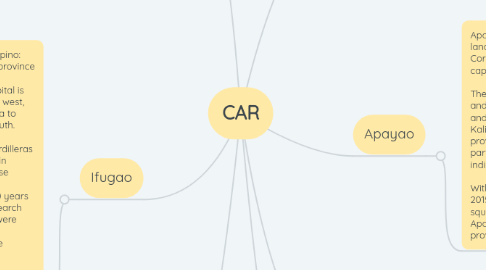CAR
by Angelene Sacramento

1. Mountain Province
1.1. Mountain Province (Filipino: Lalawigang Bulubundukin), is a landlocked province of the Philippines in the Cordillera Administrative Region in Luzon. Its capital is Bontoc. Mountain Province was formerly referred to as Mountain in some foreign references. The name is usually shortened by locals to Mt. Province. The province was named so for being in the Cordillera Central mountain range found in the upper realms of Luzon island. Mountain Province was also the name of the historical province that included most of the current Cordillera provinces. This old province was established by the Philippine Commission in 1908,[3][4][5] and was later split in 1966 into Mountain Province, Benguet, Kalinga-Apayao and Ifugao.[6][7][8] The province is also known for its mummy caves, which contain naturally mummified bodies, and for its hanging coffins.[6]
2. Ifugao
2.1. Ifugao (Ilokano: Probinsia ti Ifugao; Filipino: Lalawigan ng Ifugao) is a landlocked province of the Philippines in the Cordillera Administrative Region in Luzon. Its capital is Lagawe and it borders Benguet to the west, Mountain Province to the north, Isabela to the east, and Nueva Vizcaya to the south. The Rice Terraces of the Philippine Cordilleras and Banaue Rice Terraces are the main tourist attractions in the province. These terraces are believed to have been hand-carved into the mountains 2,000 years ago to plant rice. However, recent research by carbon dating suggests that they were built much later.[3] In 1995, they were declared as a UNESCO World Heritage Site.[4] In 2008 and 2015, the Hudhud chants of the Ifugao and the Punnuk (Tugging rituals and games) were inscribed in the UNESCO Intangible Cultural Heritage Lists.[5][6]
3. Baguio
3.1. Baguio, officially the City of Baguio (Ibaloi: Ciudad ne Bagiw; Ilokano: Siudad ti Baguio; Filipino: Lungsod ng Baguio) and popularly referred to as Baguio City, is a mountain resort city located in Northern Luzon, Philippines. It is known as the Summer Capital of the Philippines, owing to its cool climate since the city is located approximately 1,540 meters (5,050 feet) above sea level in the Luzon tropical pine forests ecoregion, which also makes it conducive for the growth of mossy plants and orchids.[3] Baguio is classified as a Highly Urbanized City (HUC). It is geographically located within Benguet, serving as the provincial capital from 1901 to 1916,[4] but has since been administered independently from the province following its conversion into a chartered city. The city has become the center of business, commerce, and education in northern Luzon, as well as the regional center of the Cordillera Administrative Region.[5] According to the 2015 census, Baguio has a population of 345,366.[2] Baguio was established as a hill station by the Americans in 1900 at the site of an Ibaloi village known as Kafagway. It was the United States' only hill station in Asia.[6] The name of the city is derived from bagiw, the Ibaloi word for "moss".
4. Apayao
4.1. Apayao (Ilokano: Probinsia ti Apayao) is a landlocked province in the Philippines in the Cordillera Administrative Region in Luzon. Its capital town is Kabugao. The province borders Cagayan to the north and east, Abra and Ilocos Norte to the west, and Kalinga to the south. Prior to 1995, Kalinga and Apayao comprised a single province named Kalinga-Apayao, which was partitioned to better service the needs of individual ethnic groups. With a population of 119,184 (as of the 2015 census)[2] covering an area of 4,413.35 square kilometres (1,704.00 sq mi),[1] Apayao is the least densely-populated province in the Philippines.
5. Abra
5.1. Abra (Ilokano: Probinsia ti Abra; Filipino: Lalawigan ng Abra) is a landlocked province of the Philippines in the Cordillera Administrative Region in Luzon. Its capital is Bangued, and is bordered by Ilocos Norte on the northwest, Apayao on the northeast, Kalinga on the mid-east, Mountain Province on the southeast, and Ilocos Sur on the southwest.
6. Kalinga
6.1. Kalinga (Ilokano: Probinsia ti Kalinga; Filipino: Lalawigan ng Kalinga) is a landlocked province in the Philippines situated within the Cordillera Administrative Region in Luzon. Its capital is Tabuk and borders Mountain Province to the south, Abra to the west, Isabela to the east, Cagayan to the northeast, and Apayao to the north. Kalinga and Apayao are the result of the 1995 partitioning of the former province of Kalinga-Apayao; which was seen to better service the respective needs of the various indigenous peoples in the area.
7. Benguet
7.1. Benguet (Tagalog pronunciation: [beŋˈɡet]; Ibaloi: Probinsya ne Benguet; Ilokano: Probinsia ti Benguet; Pangasinan: Luyag na Benguet; Filipino: Lalawigan ng Benguet), is a landlocked province of the Philippines located in the southern tip of the Cordillera Administrative Region in the island of Luzon. Its capital is La Trinidad. The highland province is known as the Salad Bowl of the Philippines due to its huge production of upland vegetables.[1][2][5] Situated within the interior of Benguet is the highly urbanized city of Baguio, which is administratively independent from the province


